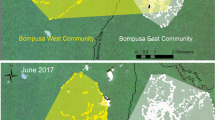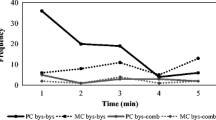Abstract
Most of what we know about postconflict behavior comes from studies on chimpanzees and other Old World semiarboreal and semiterrestrial species. Few studies have investigated whether the context of a fight affects reconciliation—selective postconflict attraction between former opponents—and consolation: selective attraction between conflict participants and other group members. We studied social conflict and its aftermath in two captive groups of brown capuchins (Cebus apella), an arboreal New World species. We observed postconflict behavior in two contexts: (1) during the presence of highly attractive, clumped food—food condition—and (2) in the absence of such food—nonfood condition. Commercial monkey chow was available ad libitum in the nonfood condition. A comparison of postconflict and control observations revealed a conciliatory tendency in the capuchins, but only following fights that occurred in the absence of highly attractive food. Other group members tended not to seek postconflict contact with former conflict participants. However, when shortly after fights recipients of aggression, but not aggressors, initiated affiliation with third parties, the latter not only allowed proximity or contact but also often reciprocated through grooming, play, and especially the exchange of friendly signals. We discuss these results within the framework of current knowledge of postconflict behavior with special emphasis on similarities and differences in the postconflict behavior of Cebus and Pan.
Similar content being viewed by others
REFERENCES
Altmann, S. A. (1962). A field study of the sociobiology of rhesus monkeys (Macaca mulatta). Ann. N.Y. Acad. Sci. 102: 338–435.
Aureli, F. (1992). Post-conflict behavior among wild long-tailed macaques (Macaca fascicularis). Behav. Ecol. Sociobiol. 31: 329–337.
Aureli, F., and van Schaik, C. P. (1991). Post-conflict behaviour in long-tailed macaques (Macaca fascicularis). I. The social events. Ethology 89: 89–100.
Aureli, F., van Schaik, C. P., and van Hooff, J. A. R. A. M. (1989). Functional aspects of reconciliation among captive long-tailed macaques (Macaca fascicularis). Am. J. Primatol. 19: 39–51.
Aureli, F., Veenema, H. C., van Panthaleon van Eck, C. J., and van Hooff, J. A. R. A. M. (1993). Reconciliation, consolation, and redirection in Japanese macaques (Macaca fuscata). Behaviour 124: 1–21.
Aureli, F., Das, M., Verleur, D., and van Hooff, J. A. R. A. M. (1994). Post-conflict social interactions among barbary macaques (Macaca sylvanus). Int. J. Primatol. 15: 471–485.
Aureli, F., Das, M., and Veenema, H. C. (1997). Differential kinship effect on reconciliation in three species of macaques (Macaca fascicularis, Macaca fuscata, and Macaca sylvanus). J. Comp. Psychol. 111: 91–99.
Bierens de Haan, J. A. (1931). Werkzeuggebrauch und Werkzeugherstellung bei einem niederen Affen (Cebus hypoleucus Humb.). Z. Vergleichende Physiol. 13: 639–695.
Chevalier-Skolnikoff, S. (1989). Spontaneous tool use and sensorimotor intelligence in Cebus compared with other monkeys and apes. Behav. Brain Sci. 12: 561–627.
Cords, M. (1993). On operationally defining reconciliation. Am. J. Primatol. 29: 225–267.
Das, M., Penke, Z., and van Hooff, J. A. R. A. M. (1996). Post-conflict behavior of the aggressor in a captive social group of long-tailed macaques (Macaca fascicularis). Paper presented at the XVIth Congress of the International Primatological Society and the XIXth Conference of the American Society of Primatologists, Madison, WI, abstract No. 554.
Das, M., Penke, Z., and van Hooff, J. A. R. A. M. (1997). Affiliation between aggressors and third parties following conflicts in long-tailed macaques (Macaca fascicularis). Int. J. Primatol. 18: 159–181.
de Waal, F. B. M. (1984). Coping with social tension: sex differences in the effect of food provision to small rhesus monkey groups. Anim. Behav. 32: 765–773.
de Waal, F. B. M. (1987). Tension regulation and nonreproductive functions of sex among captive bonobos (Pan paniscus). Natl. Geogr. Res. 3: 318–335.
de Waal, F. B. M. (1989). Food sharing and reciprocal obligations among chimpanzees. J. Human. Evol. 18: 433–459.
de Waal, F. M. M. (1993). Reconciliation among primates: A review of empirical evidence and unresolved issues. In Mason, W. A., and Mendoza, S. P. (eds.), Primate Social Conflict, SUNY Press, Albany, pp. 111–144.
de Waal, F. B. M. (1997). Bonobo: The Forgotten Ape, University of California Press, Berkeley.
de Waal, F. B. M., and Aureli, F. (1996). Consolation, reconciliation, and a possible cognitive difference between macaque and chimpanzee. In Russon, A. E., Bard, K. A., and Parker, S. T. (eds.), Cambridge University Press, Cambridge, pp. 80–110.
de Waal, F. B. M., and Luttrell, L. (1991). Cebus global protocol. Unpublished manuscript.
de Waal, F. B. M., and Ren, R. (1988). Comparison of the reconciliation behavior of stumptail and rhesus macaques. Ethology 78: 129–142.
de Waal, F. B. M., and van Roosmalen, A. (1979). Reconciliation and consolation among chimpanzees. Behav. Ecol. Sociobiol. 5: 55–66.
de Waal, F. M. M., and Yoshihara, D. (1983). Reconciliation and redirected affection in rhesus monkeys. Behaviour 85: 224–241.
de Waal, F. B. M., van Hooff, J. A. R. A. M., and Netto, W. J. (1976). An ethological analysis of types of agonistic interaction in a captive group of Java-monkeys (Macaca fascicularis). Primates 17(3): 257–290.
Fragaszy, D. M., and Bard, K. (1997). Comparison of development and life history in Pan and Cebus. Int. J. Primatol. 18: 683–701.
Fragaszy, D. M., Actam-Curtis, L. E., Baer, J. F., and Carlson-Lammers, R. (1989). Forelimb dimensions and goniometry of the wrist and fingers in tufted capuchin monkeys (Cebus apella): Developmental and comparative aspects. Am. J. Primatol. 17: 133–146.
Freese, C. H., and Oppenheimer, J. R. (1981). The capuchin monkeys, genus Cebus. In Ecology and Behavior of Neotropical Primates, Vol. 1, Academic Brasileira de Ciências, Rio de Janeiro.
Goodall, J. (1986). The Chimpanzees of Gombe, Belknap, Cambridge, MA.
Janson, C. H. (1984). Female choice and mating system of the brown capuchin monkey Cebus apella (Primates: Cebidae). Z. Tierpsychol. 65: 177–200.
Janson, C. H. (1985). Aggressive competition and individual food intake in wild brown capuchin monkeys. Behav. Ecol. Sociobiol. 18: 125–138.
Janson, C. H. (1986). Capuchin counterpoint. Nat. Hist. 95: 44–53.
Janson, C. H. (1988). Food competition in brown capuchin monkeys (Cebus apella): Quantitative effects of group size and tree productivity. Behaviour 105: 53–76.
Judge, P. G. (1991). Dyadic and triadic reconciliation in pigtail macaques. Am. J. Primatol. 23: 225–237.
Kappeler, P. M., and van Schaik, C. P. (1992). Methodological and evolutionary aspects of reconciliation among primates. Ethology 92: 51–69.
Klüver, H. (1937). Re-examination of implement-using behavior in a Cebus monkey after an interval of three years. Acta Psychol. 2: 347–397.
Knox, K. L., and Stone Sade, D. (1991). Social behavior of the emperor tamarin in captivity: Components of agonistic display and the agonistic network. Int. J. Primatol. 12: 473–480.
Kuroda, S. (1980). Social behavior of the pygmy chimpanzees. Primates 21: 181–197.
Manson, J. H., Perry, S., and Parish, A. R. (1997). Nonceptive sexual behavior in bonobos and capuchins. Int. J. Primatol. 18: 767–786.
Matsumura, S. (1996). Postconflict affiliative contacts between former opponents among wild moor macaques (Macaca maurus). Am. J. Primatol. 38: 211–219.
O'Brien, T. G. (1993). Allogrooming behaviour among adult female wedge-capped capuchin monkeys. Anim. Behav. 46: 499–510.
Perry, S. (1995). Social Relationships in Wild White-Faced Capuchins (Cebus capucinus), Unpublished dissertation, University of California, Los Angeles.
Perry, S. (1996). Intergroup encounters in wild white-faced capuchins (Cebus capucinus). Int. J. Primatol. 17: 309–330.
Robinson, J. G. (1981). Spatial structure of foraging groups of wedge-capped capuchin monkeys (Cebus nigrivattatus). Anim. Behav. 29: 1036–1056.
Robinson, J. G. (1982). Vocal systems regulating within-group spacing. In Snowdon, C., Brown, C., and Peterson, M. (eds.), Primate Communication, Cambridge University Press, Cambridge, pp. 94–116.
Robinson, J. G. (1984). Syntactic structures in the vocalizations of wedge-capped capuchin monkeys, Cebus nigrivattatus. Behaviour 90: 46–79.
Robinson, J. G., and Janson, C. H. (1987). Capuchins, squirrel monkeys, and atelines: Socioecological convergence with Old World primates. In Smuts, B. et al. (eds.), Primate Societies, University of Chicago Press, Chicago, pp. 69–82.
Rowell, T. E. (1988). The social system of guenons, compared with baboons, macaques and mangabeys. In Gautier-Hion, A., Bourliere, F., Gautier, J. P., and Kingdon, J. (eds.), A Primate Radiation: Evolutionary Biology of the African Guenons, Cambridge University Press, Cambridge, pp. 439–451.
Siegel, S. (1956). Nonparametric Statistics for the Behavioral Sciences, McGraw-Hill, New York.
Strier, K. B. (1994). Myth of the typical primate. Yearbk. Phys. Anthropol. 37: 233–271.
Sutcliffe, A. G., and Poole, T. B. (1984). Intragroup agonistic behavior in captive groups of the common marmoset Callithrix jacchus jacchus. Int. J. Primatol. 5: 473–487.
van Hooff, J. A. R. A. M. (1967). The facial displays of the catarrhine monkeys and apes. In Morris, D. (ed.), Primate Ethology, Weidenfeld and Nicholson, London, pp. 7–68.
Veenema, H. C., Das, M., and Aureli, F. (1994). Methodological improvements for the study of reconciliation. Behav. Process 31: 29–38.
Verbeek, P. (1995). Agonism and Its Aftermath in a Captive Group of Cebus apella, Unpublished master's thesis, Emory University, Atlanta, GA.
Visalberghi E. (1988). Responsiveness to objects in two social groups of tufted capuchin monkeys (Cebus apella). Am. J. Primatol. 15: 349–360.
Visalberghi, E., and Fragaszy, D. M. (1989). Do monkeys ape? In Parker, S., and Gibson, K. (eds.), Language and Intelligence in Monkeys and Apes, Cambridge University Press, Cambridge.
Visalberghi, E., and Welker, C. (1986). Sexual behavior in Cebus apella. Anthropol. Contemp. 9: 164–165.
Watts, D. P. (1995). Post-conflict social events in wild mountain gorillas. II. Redirection, side direction and consolation. Ethology 100: 158–174.
Weigel, R. M. (1979). The facial expressions of the brown capuchin monkey (Cebus apella). Behaviour 68: 250–276.
Welker, C. (1979). Zum Sozialverhalten des Kapuzineraffen Cebus apella cay ILLIGER, 1815, in Gefangenschaft I. Philippia IV(2): 154–168.
Welker, C. (1981). Zum Sozialverhalten des Kapuzineraffen Cebus apella cay ILLIGER, 1815, in Gefangenschaft II. Philippia IV(4): 331–342.
Westergaard, G. C., and Fragaszy, D. M. (1987). the manufacture and use of tools by capuchin monkeys (Cebus apella). J. Comp. Psychol. 2: 159–168.
York, A. D., and Rowell, T. E. (1988). Reconciliation following aggression in patas monkeys, Erythrocebus patas. Anim. Behav. 36: 502–509.
Author information
Authors and Affiliations
Rights and permissions
About this article
Cite this article
Verbeek, P., de Waal, F.B.M. Postconflict Behavior of Captive Brown Capuchins in the Presence and Absence of Attractive Food. International Journal of Primatology 18, 703–725 (1997). https://doi.org/10.1023/A:1026391728909
Issue Date:
DOI: https://doi.org/10.1023/A:1026391728909




